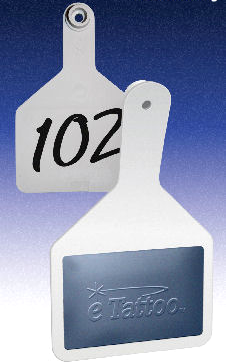
Eriginate™ Corporation announced Dec. 28 the approval of its eTattoo™ tag by the United States Department of Agriculture (USDA). The approval marks the first ultra-high radio frequency identification tag (UHF RFID) and the first non-low frequency tag (LF) to be approved for use with the “840” Animal Identification Number (AIN).
“We’re very pleased that the USDA has provided approval for eTattoo™ to be used as an official identification device in USDA’s animal health programs,” says Bob Baarsch, CEO of Eriginate. “Animal identification plays an important role when animal disease events occur, and we are proud to be able to offer our technology to enrich this effort.”
eTattoo™ is the first and only cattle management system to utilize UHF RFID, operating at 915 MHz. The tag allows users to collect data from individual animals housed in large pens or across groups of pens in a fraction of a second, even while animals are moving. The read range is optimized to allow producers to collect data from either the front or back of the animal at a distance of up to 25 feet using a fixed reader or up to 15 feet using a handheld device.
eTattoo™ is a panel-style tag that incorporates both visual and electronic identification, enabling management information to be printed on the tag and alleviating the need for separate visual and RFID tags. Because of the enhanced performance of the eTattoo™ technology, the tags and readers can be quickly incorporated into existing cattle handling systems without the need for costly infrastructure changes.
Animals that move individually through the production and processing chain can be identified with an official AIN tag or device. Only approved manufacturers are authorized to produce AIN devices, and eTattoo™ is the first UHF RFID ear tag to be authorized as an official AIN device. UHF-RFID is a global standard used throughout the world for asset tracking. The eTattoo™ tag is compatible with all ISO 18000-6C / EPCglobal Gen 2 readers and equipment.
The dangle design also enables both visual and electronic identification, so producers can include management and parentage information on the tag for easier sorting and grouping. This alleviates the need to have visual and RFID tags by incorporating both features into one product, and will make it easier for producers to take advantage of the technology. Along with the tags, is a specified handheld or fixed-position reader and antenna to enable data collection from the tags. Recommended units are available from Eriginate.
eTattoo™ was most-recently demonstrated in a real-world testing environment in November 2008 at the Holton, Kansas-Livestock Exchange. In less than one hour an antenna was installed on the left side of the sale ring. A group of eighteen steers carrying eTattoo™ UHF RFID tags were run through the sale ring. All tags were read with 100% accuracy within 20 seconds with the one stationary antenna.
Ultra-high frequency differs from low-frequency tags in significant ways. First, UHF RFID enables a longer read range which makes it more robust under field conditions. Also, because of its shorter wavelength, UHF RFID is less susceptible to interference. UHF RFID can also accept much more data at a much higher transfer rate. The highest possible data rate at the 915 MHz frequency of the UHF RFID technology is about two megabytes per second. Comparatively, the highest possible data rate at the 125 KHz offered by low-frequency technology is approximately 50 bits per second.
While low-frequency technology has been available in warehouse management for more than 10 years, several significant retail and consumer-based entities have moved to the newer ultra high-frequency technology for asset management and tracking. These include the U.S. Department of Defense, Wal-Mart and Target. These entities demand that their suppliers utilize UHF RFID asset tags on products they receive. Of great importance, too, is the fact that UHF has been accepted as a global standard—recognized by both the EPC global and ISO standards organizations.
“The hardware, software and service network already exist to support UHF RFID,” says Junek. “Wal-Mart and Target have already adopted this global standard for tracking inventories and have helped create a UHF RFID infrastructure that can readily adapt to the cattle industry.”
Starter kits and tags are currently available from Eriginate for those producers ready to implement the technology. For more information on eTattoo™ and to order a kit or tags, call Eriginate customer service at (785) 694-3468 or visit clicking HERE.
